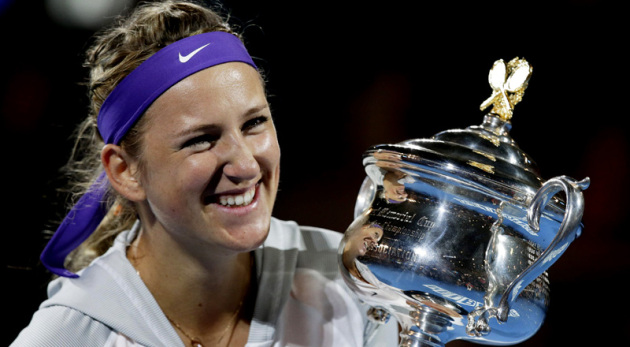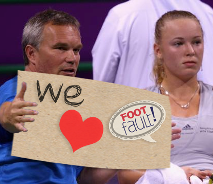
It was 2007 when near-mute whispers of the rising new generation fast transformed into ear-splittingly loud warning sirens. First came Agnieszka Radwanska, who immediately found success - and daft comparisons to Martina Hingis - as she broke the elite glass ceiling, scaling her first Grand Sam quarterfinal and securing a myriad of notable scalps. Caroline Wozniacki’s slow but seamless rise up the rankings followed, her consistency complimented with a never-faltering transition from junior to senior success.
Following slowly in the footsteps of both was a Belarusian by the name of Victoria Azarenka. Though Azarenka navigated a junior career as successful as her peers, capturing two Grand Slams and occupying the top ranking, her profile remained far smaller and little was known about this young champion. Still, the buzz surrounding her told of a fiery Belarusian who had recently relocated to Scottsdale, Arisona and struck the ball with an authority that rivalled the likes of Sania Mirza and Mary Pierce, with intensity, mental strength and - of course - noise reminiscent of Maria Sharapova.
As Azarenka slowly rose to prominence during the latter half of that year, if one thing that became clear, it was that she clearly believed that hype. When competing, her sole aim was to attack relentlessly, punishing opponents with brute force and capturing matches with her sheer weaponry. She attempted, like so many before her, to steal the initiative immediately and tackle matches at her own pace.
In short, it was pure delusion.
Here was a player who struggled to breach the 90 miles-per-hour mark on serve and couldn’t tackle a low forehand without comically scooping the ball up. She lacked natural power and many of her losses were a simple case of her being overpowered and hit off the court. Moreover, the grunting and her angry, aggressive attitude were simply a facade for the actual pace of her shots, which would have left the aforementioned Pierce chuckling at such inane comparisons.
Though she unarguably found success, finishing 2007 in the top 30 and then breaking the top 10 within two years of her rise to senior prominence, the early years of Azarenka’s career would see the Belarusian attempting a style of play that was not her own. Consequently, she was often forced to watch on hopelessly as her peers - whether it was Wozniacki whose smooth rise up the rankings continued until, at number one, she met an impenetrable ceiling; or Petra Kvitova who easily caught up with the Belarusian’s headstart before breezing past, rising from relative obscurity to a Grand Slam title within a year – outshined her on the biggest stages.
In 2011, four years after her breakthrough year, everything changed.
Many, including Azarenka herself, credit a change in her attitude for her ultimate breakthrough between 2012 and 2013. After her second Miami triumph in 2011, she spoke about the frustration that built up as the career she envisioned for herself had, at that moment, failed to materialize and left her incoherently discussing quitting the game altogether. A chat with her grandmother changed everything.
“I said I didn’t want to do something that I’m not enjoying. She said: ‘Then don’t do it. You have to be happy’. She was telling me these stories, about how hard she was working. She was actually working in a kindergarten with kids. She’s been doing a lot of work, having two, three jobs at one time. It was like: ‘Well, you just have to shut up and stop complaining because you have a pretty damn good life. Just work out there.
My Mum asked me: ‘What are you going to do?’ I said: ‘I’m going to study.’ She laughed out loud. She knows that I like to study, but I’m not going to be fulfilling that for a long time. I’m just going to get bored, because tennis is what I really love. I just had to take a step back and realise that is true. My mother’s a very wise woman. She said: ‘Just come back home, enjoy some time, and you decide’.”
From then onwards, she seemingly assumed a new identity. Previously, after perilously tight points and frustrating misses, she would systematically implode and/or explode – either mentally collapsing, combusting with pure anger or somehow both simultaneously. Azarenka’s waltz through the Miami draw showcased a new side to her, however, as such tight moments were met with clarity and she thought through frustration rather than allowing it to consume her. Many volatile and mentally weak players have been able to gradually improve with time and effort, but it is almost unprecedented for a player - a top player no less - to make such a career-altering and dramatic improvement seemingly overnight.
In tennis, the mental side is so undeniably important, but the result is that the technical side often goes unnoticed. Equally pivotal to Azarenka’s rise to the top was her enlisting of Sam Sumyk in a quite bizarre coach swap between Azarenka and her sporadic doubles partner, Vera Zvonareva. In addition to the Frenchman aiding in her newfound calmness and crucially transforming her forehand from the previous comical scoop into a formidably solid stroke, he also clearly understood Azarenka’s game and what she needed to change to break the glass ceiling. It was during a press conference at the Istanbul WTA Championships, I in attendance, that Azarenka unintentionally disclosed just how much had transformed in her approach.
VICTORIA AZARENKA: [...] I just really glad I could keep the consistency and put a lot of pressure on Vera so she wouldn’t make so many winners.
I really tried to hang in there, and that was important to be consistent and aggressive, you know, find that balance.
[...]
VICTORIA AZARENKA: Just have to be, you know, consistent and aggressive. Tomorrow is gonna be different day. I don’t really want to look back into our last previous matches. I mean, both times she won a tournament she was in her best form.
Now she’s playing good, as well as I am. It’s gonna be really tough battle, for sure. I just have to be consistent and aggressive, the same that she’s gonna try to do.
The quote doesn’t really do justice the manner in which she so pointedly and continually stressed the importance of being consistent and forcing her opponent into mistakes. I was taken aback, and have vividly remembered it ever since. Previously, the aggression had always been of utmost importance to her, to the point where everything else was irrelevant. But that point confirmed that the transformation Azarenka had undertaken was far more than mental. Of course, the evidence on-court was clear for a considerable period before Istanbul, but it was far easier during this adjustment period to assume that she was simply under-powered. However, the revelation that she was aware of exactly how to win matches, now that…that was of crucial importance.
Though many still laughably equate Azarenka’s game purely with power and aggression - most recently her own sponsor Wilson in this embarrassing ad - it is an ignorant and inaccurate portrait of the former number one. Sure, she still attempts to play aggressive tennis, but she also understands that defense is of equal importance. And when she does attack, it has nothing to do with power. She achieves it through brilliantly constructed points rather than trying and failing to hit through opponents. She prods and pokes, pressing the opponent with depth and smart shot placement – sometimes she doggedly refuses to relinquish her grip on her opponent’s weak spot until it breaks down, other times she irreverently changes direction at will and forces the opponent to scatter around the court at full speed. And the second an opportunity - any opportunity - to finish the point presents itself, she is the first to take advantage.
This new approach means that even when her game is suffering, Azarenka still possesses enough to tackle the majority of opponents. When she makes too many errors or her timing is failing, she is quick to rein her game in and rely on her defence. Moreover, the clarity that has graced her game allows her to properly focus on other aspects of her game. For example, she now compliments her stellar footwork with much-improved movement. She has also become impressively capable when on the run, under pressure from her opponent, when the ball is put in difficult positions or all at once. Finally, she now truly understands the importance of keeping her opponent guessing with well-timed drop shots, confident net forays and slick angles.
Quite simply, Victora Azarenka finally found that balance.
Like this:
Like Loading...


